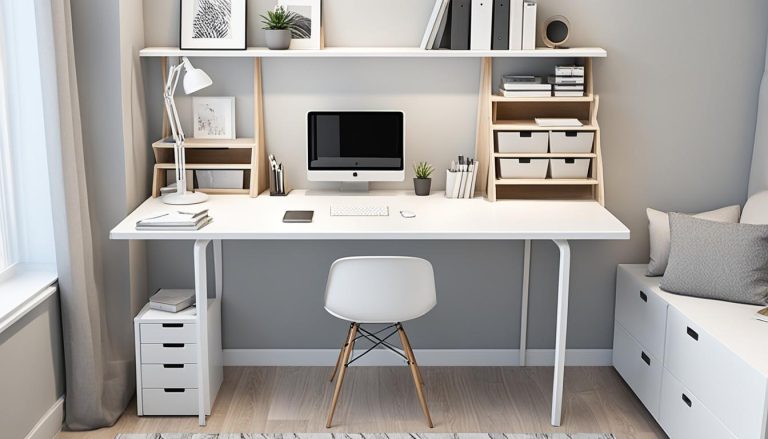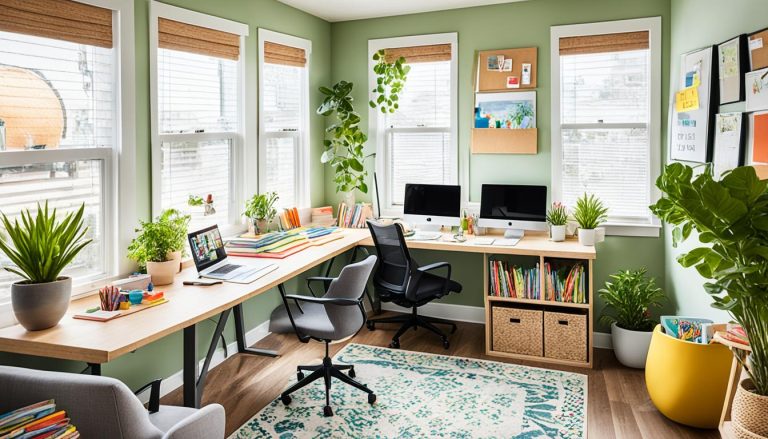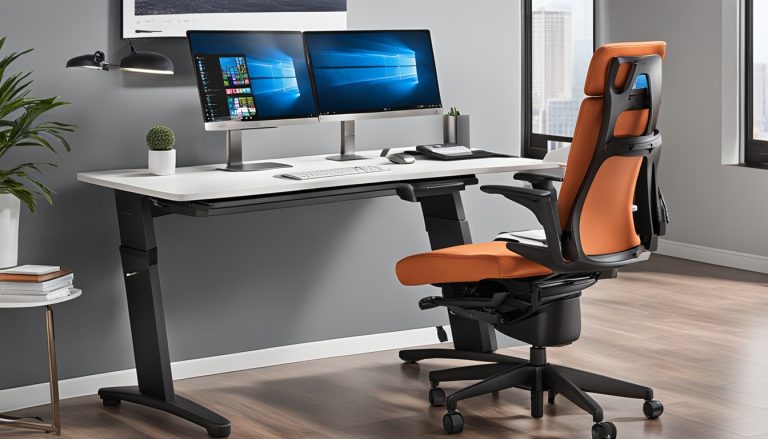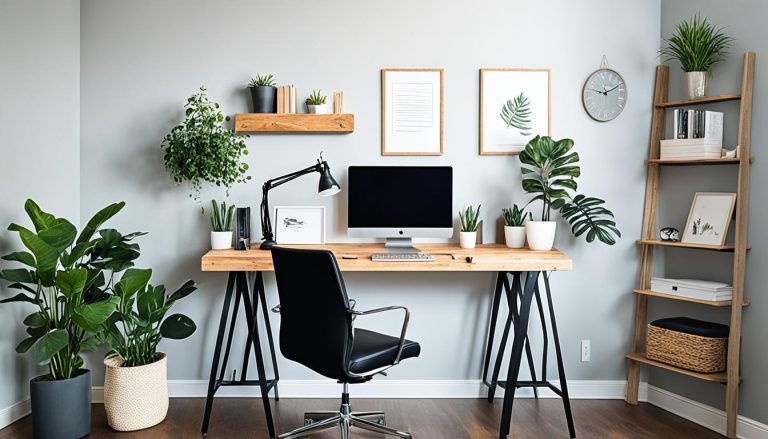Eco-Friendly Home Office Designs: Green Workspace Tips
houseremodelingnews.com may earn a commission if you purchase a product through one of our links
Have you ever thought about how your home office affects the planet? With more people working from home, making your office eco-friendly is key. Let’s look at some tips to help you cut down on waste and work better.
Creating a sustainable workspace is essential, not just trendy. You can use energy-saving lights and furniture made from recycled materials. For example, LED lights last much longer than old-style bulbs, which is good for the planet.
Green offices are more than just pretty. They’re healthier and help you work better. Adding plants, like cacti, can make the air cleaner and improve your mood. By choosing eco-friendly designs, you’re helping the environment and making a better place for creativity and productivity.
The Rise of Remote Work and Environmental Concerns
Remote work has become very popular, changing how we do our jobs and live. This change makes us focus more on making our home offices energy-efficient. Studies show that full-time remote workers can cut their carbon footprint by 54% compared to those working in offices.
This shift has a big impact on the environment. Working from home means less commuting, which is a big source of harmful gases. In the U.S., transportation is responsible for about 28% of greenhouse gas emissions, with a lot coming from personal cars.
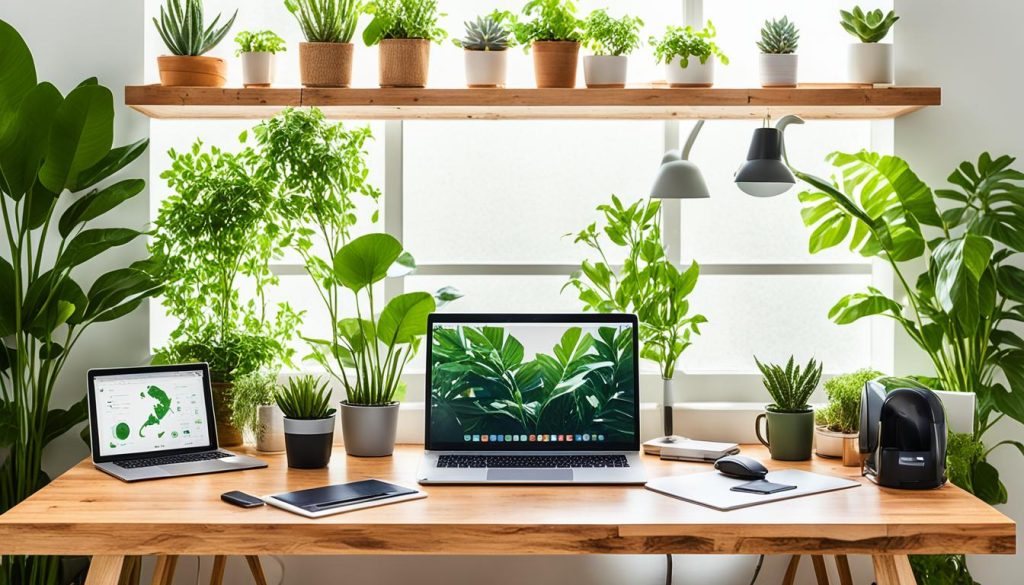
It’s important to make your home office sustainable. Green interiors not only help the planet but also make you healthier. Here are some interesting facts:
- The average office worker uses 10,000 sheets of copy paper every year.
- Office buildings use almost 17% of the nation’s energy, mostly for heating, cooling, and lighting.
- Workers who split their time between home and office can cut their carbon footprint by 11% to 29%.
By choosing remote work and creating an energy-efficient workspace, you’re doing more than saving money. You’re helping make the future greener. The growth of remote work lets us rethink our workspaces and make choices that help us and the planet.
Understanding Eco-Friendly Home Office Design
Eco-friendly home office design aims to make your workspace better for you and the planet. It’s about using sustainable practices to ensure your office is comfy, productive, and kind to the earth.
What Is Eco-Friendly Office Design?
An eco-friendly home office uses green materials and focuses on clean air inside. It’s a place that lowers its impact on the environment while keeping you comfortable and productive. Design choices range from the paint on walls to the chair you sit in.

Benefits for You and the Environment
Going for an eco-friendly home office has many perks:
- Natural elements in your space can boost your productivity by up to 15%
- Natural light during work hours helps you sleep better
- Right window treatments can cut heat loss by 10-25% in cold weather
- Green spaces are linked to lower stress and higher productivity
Key Principles of Sustainable Workspace Design
To make an eco-friendly home office, keep these tips in mind:
- Use materials like reclaimed wood or bamboo for furniture
- Make the most of natural light to cut down on energy use
- Choose energy-saving LED lights
- Add indoor plants to better the air quality
- Go for paints and finishes with low VOCs
By sticking to these tips, you’ll craft a home office that’s great for the planet and improves your work life. Remember, even small changes can greatly benefit your sustainable and productive workspace.
Choosing Sustainable Office Furniture
Choosing the right office furniture is key to a green workspace. With 85% of young people preferring sustainable products, it’s clear that eco-friendly choices are popular. Sustainable furniture cuts down on environmental harm and supports a circular economy.
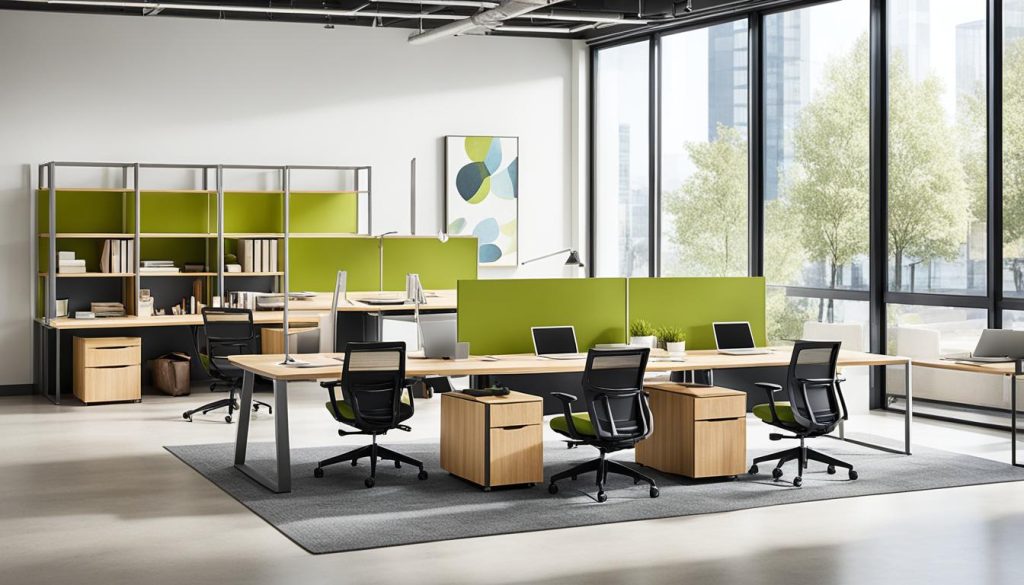
- Second-hand pieces: Visit flea markets or browse websites like Freecycle
- Recycled materials furniture: Look for items made from reclaimed wood or recycled plastics
- Bamboo furniture: A fast-growing, renewable resource
Choosing sustainable office furniture is good for the planet and your health. Regular furniture can release harmful chemicals, raising the risk of asthma and allergies. Eco-friendly options make for a healthier work environment.
“Sustainable furniture makers prioritize good working conditions and fair wages for their employees.”
The average office furniture lasts about 7 years. Investing in quality, sustainable furniture means you’re making a long-term commitment to your space and the earth. Look for furniture with BIFMA LEVEL certification. This ensures it meets strict sustainability standards.
Energy-Efficient Lighting Solutions
Lighting is key to a productive home office. Using energy-efficient lighting cuts down on environmental harm and saves money on bills.
Maximizing Natural Light
Natural light is the best choice for your workspace. Place your desk near windows to use daylight. Use light-colored curtains to control glare and let sunlight in. Mirrors can also reflect light, making darker areas brighter.

LED and Energy-Saving Bulbs
When natural light isn’t enough, LED bulbs are a great choice. They use much less energy and last much longer than old bulbs. LEDs give bright, steady light without the heat of older bulbs.
Smart Lighting Systems
Smart lighting systems are the top choice for saving energy. They adjust light based on if you’re there and how much natural light there is. You can control them from anywhere, making sure they’re never on when you’re not there. Some even let you pick the light color and intensity for your mood and tasks.
- Use task lighting for focused work areas
- Install dimmer switches to adjust light levels
- Choose warm-toned bulbs for a cozy atmosphere
By using natural light, LED bulbs, and smart systems, you can make your lighting both comfy and green. Your home office will be bright, eco-friendly, and support your work and green goals.
Eco-Friendly Paint and Wall Coverings
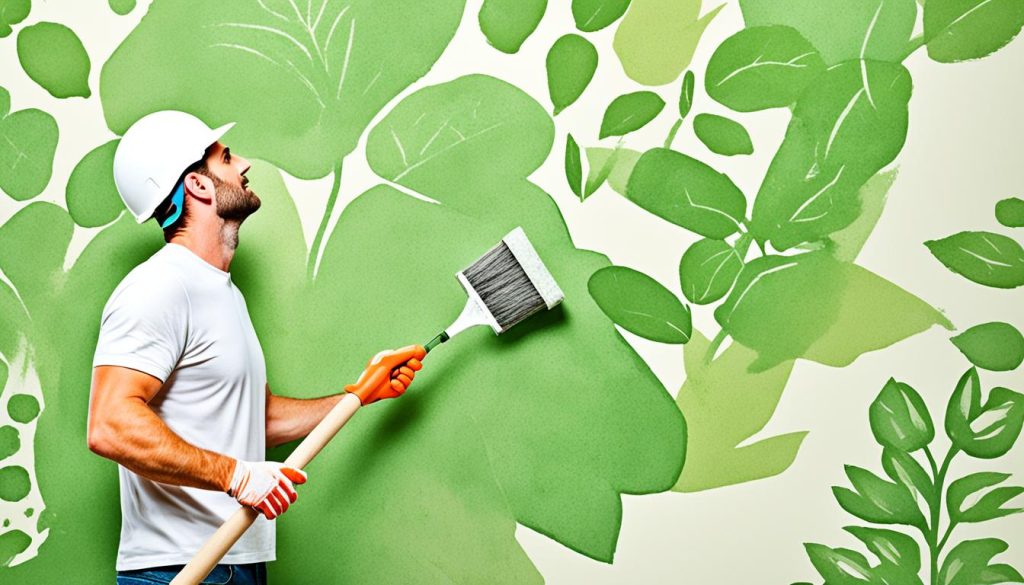
Green interior design begins with the walls. The paint and coverings you choose can greatly affect your home office’s eco-friendliness. Opting for low VOC paints is a wise choice for better indoor air quality. These paints have fewer than 250 grams of volatile organic compounds per liter for latex, and 380 grams for oil-based types.
Some brands take it a step further. Sherwin-Williams offers EcoSelect Zero VOC Interior Latex Paint. It works well on various surfaces and resists splatters. Benjamin Moore’s Ultra Spec 500 is another zero-VOC choice that’s simple to apply and clean up.
But sustainable design isn’t all about paint. Cork walls are a 100% natural and renewable choice. Wood paneling from reclaimed or FSC-certified sources adds warmth and is eco-friendly. For a unique touch, try grasscloth made from natural fibers like hemp or bamboo.
“Choosing eco-friendly paints and wall coverings is an easy way to make your home office greener and healthier.”
Light colors can help reflect natural light, reducing energy use. By selecting the right paints and coverings, you’re not just making a stylish space. You’re also supporting sustainable design and improving your indoor air quality.
Incorporating Indoor Plants for Better Air Quality
Adding indoor plants to your workspace can change the game. This approach, known as biophilic design, makes your space look better and breathe easier. Studies reveal that houseplants can clear up to 87% of harmful toxins in just 24 hours. This makes your home office a healthier spot to work.
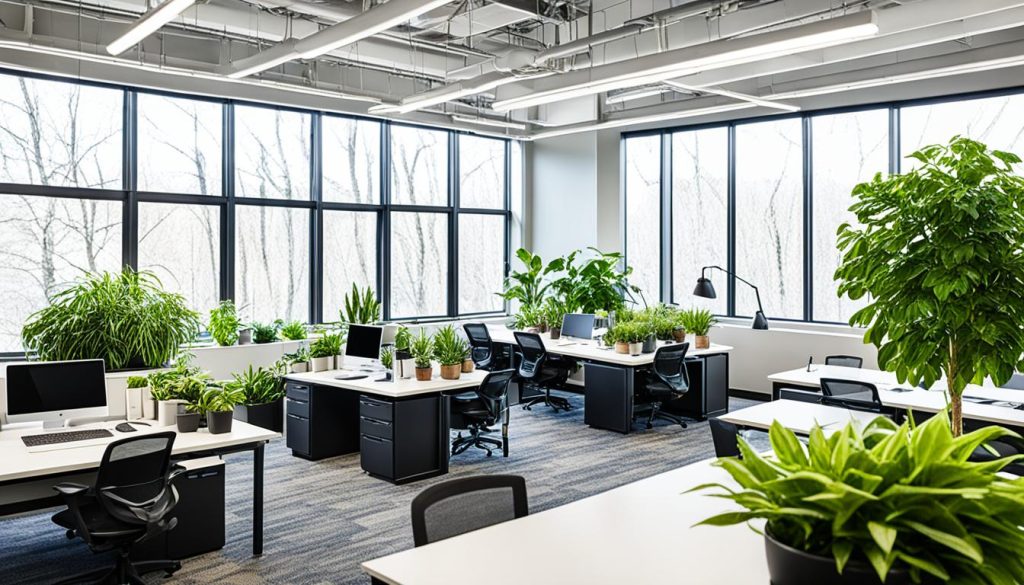
Best Plants for Home Offices
Pick plants that do well in offices and clean the air:
- Snake Plants: Remove formaldehyde, xylene, and benzene
- Peace Lilies: Eliminate benzene and ammonia
- Spider Plants: Filter out formaldehyde and xylene
- Boston Ferns: Excellent for removing toluene
Air-Purifying Qualities
Indoor plants clean the air naturally, getting rid of harmful stuff. Aloe vera, for example, gets rid of formaldehyde from cleaning products. Chrysanthemums take out ammonia, and pothos deals with benzene. Adding these plants makes your space cleaner and fresher, helping your health and work.
Aesthetic and Psychological Benefits
Plants do more than just clean the air. They help reduce stress, make you feel better, and help you focus. Studies show they can boost productivity by up to 15%. Seeing greenery in your space makes it calming, which improves your well-being and job satisfaction.
“Plants have been proven to enhance memory and cognitive abilities.”
By adding indoor plants to your office, you follow biophilic design. This creates a space that helps your work and health. This easy yet powerful way to design your workspace can make your daily work better, making it more fun and efficient.
Sustainable Flooring Options

Choosing sustainable flooring is crucial for eco-friendly home offices. These materials not only look good but also help the planet. Let’s look at some great options for your home office floor.
Bamboo and cork are top choices for sustainable flooring. Bamboo grows fast, making it very renewable. Cork comes from tree bark and is durable and insulating. It also fights mold, mildew, and termites, lasting longer than many wood floors.
Organoid flooring is another unique option. It’s made from alpine hay and flowers and is good for the planet. In 2019, it removed over 92,000 pounds of carbon dioxide from the air, which is like driving 211,266 miles less.
- Linoleum: Made from natural materials like linseed oil and cork powder
- Reclaimed wood: Gives new life to old materials
- Engineered hardwood: Combines durability with natural beauty
Craft Artisan Wood Floors offers sustainable flooring with certifications for green practices. Their products have low VOC emissions, which is great for your office’s air quality.
“Sustainable flooring isn’t just about being green. It’s about creating a healthier, more productive workspace.”
Your choice of flooring affects your work space and the planet. By picking eco-friendly options, you’re helping the environment and making a beautiful, useful home office.
Eco-Friendly Home Office Designs: Practical Examples
More people are working from home, making green office interiors popular. Let’s look at some eco-friendly home office designs that are stylish and sustainable.

Organic modern design is a top choice. It uses natural materials like wood, stone, or bamboo. This style goes for a calm look with neutral colors, helping you stay focused.
Biophilic design is also big in green offices. A survey showed 93% of Americans add nature to their spaces. Adding plants like succulents or ferns cleans the air, lowers stress, and makes you more productive.
- Use open shelving for organization and visual interest
- Choose minimalist furniture for aesthetics and functionality
- Incorporate textured elements like woven rugs for a cozy atmosphere
Letting in natural light is key in eco-friendly offices. It makes you feel better and work better, and it cuts energy use by 20-60%. Place your desk near a window to get more daylight.
“Natural ventilation can reduce air conditioning energy use by 10-30% annually, improving energy efficiency and lowering costs.”
Creating a green office doesn’t mean it can’t look good. With these tips, you can make an eco-friendly home office that’s both stylish and good for the planet.
Reducing Paper Usage and Waste Management
Making your office zero-waste is simpler than you think. By using digital tools and smart waste management, you can make your workspace eco-friendly. Let’s look at ways to cut down on paper use and manage waste well in your sustainable office.
Digitalization Strategies
Join the digital world to cut down on paper. Use cloud storage for your documents and choose digital signatures. Did you know DocuSign has saved over 6 million trees since 2003 by replacing 55.8 billion paper sheets? Going paperless helps you organize better and makes a big difference for the environment.

Recycling and Composting
Start a recycling system in your home office. Sort waste into organics, recyclables, and non-recyclables. Composting organic waste helps reduce landfill waste. For items that can’t be composted, look for new recycling options that are getting better thanks to technology.
Eco-friendly Office Supplies
Use recycled office supplies in your sustainable workspace. Pick refillable pens, recycled paper, and reusable sticky notes. These small changes can make a big impact. Remember, UK office workers use up to 45 pieces of paper a day, with most ending up as waste. Choosing eco-friendly supplies cuts down on this waste.
“Sustainability is not a choice, it’s a necessity for businesses today.” – Environmental advocate
By using these strategies, you’re helping create a zero-waste office and joining a global movement. With 61% of people seeing sustainability as a must for businesses, your efforts are part of a growing trend. Start small, dream big, and watch your sustainable office grow!
Energy-Efficient Technology and Equipment
Making your office energy-efficient is key for a green workspace. By picking the right tech and gear, you can cut down on power use and lessen your carbon footprint. Let’s look at ways to make your home office greener.
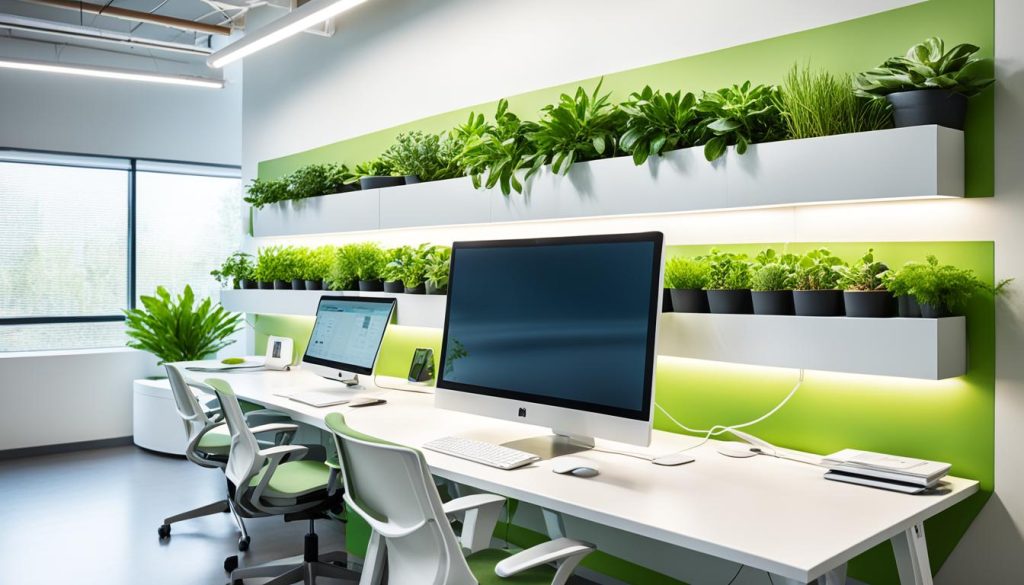
Begin by choosing Energy Star-rated appliances for your eco-friendly office. These gadgets use 50% less energy than usual, saving you money on bills. When buying computers, printers, and other gear, always check for the Energy Star label.
Power strips with control plugs are a smart choice for any green office. They stop devices from using power when not in use. Just flip the power strip off when you’re done to save energy from all connected devices.
- Use LED desk lamps for task lighting
- Opt for laptops instead of desktop computers
- Choose multi-function devices to reduce the number of appliances
Think about adding renewable energy sources to your office setup. Solar panels can power your gear and lessen your need for the grid. Although the start-up cost is higher, you’ll save money over time and help the planet.
“Sustainable office design can improve productivity by as much as 20%.”
With these energy-efficient techs, you’ll have a more sustainable and effective workspace. Remember, even small changes can make a big difference in your energy use and the environment.
Creating a Minimalist and Clutter-Free Workspace
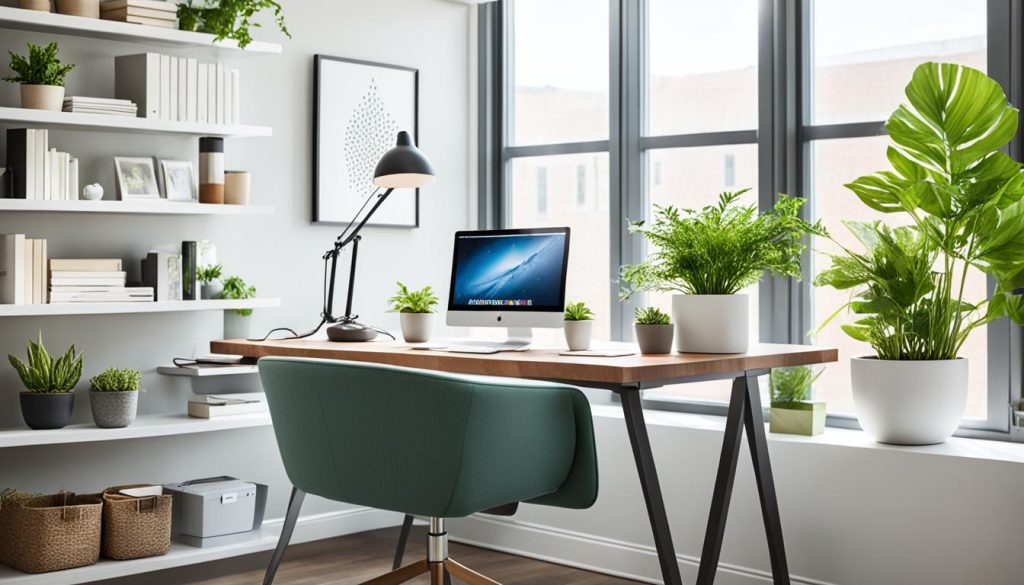
A clutter-free workspace helps you stay productive and feel calm. Research shows that 85% of workers feel more stressed with a messy desk. By choosing minimalist decor, you can make your home office both eco-friendly and more focused.
Begin by sorting your office items into categories. Put them into office supplies, keepsakes, electronics to recycle, and trash. Amazingly, 75% of what’s in a home office can be recycled. This method helps you declutter while being kind to the planet.
Use smart storage to keep your space looking minimalist. Label your file folders or use open baskets for keeping documents tidy. Over time, you might find you need fewer files, which means less paper and supporting eco-friendly habits.
Here are some tips for a tidy workspace:
- Set aside time each night to organize one pile at a time
- Invest in furniture that serves more than one purpose to save space
- Choose a well-lit workspace to boost productivity by 24%
- Go for ergonomic chairs to increase productivity by 17%
Remember, 70% of employees feel more motivated in a minimalist setting. A clean, organized space not only helps you work better but also looks professional during video calls. Adopt these eco-friendly home office ideas for a space that’s both efficient and good for the planet.
Natural Ventilation and Temperature Control
Creating an energy-efficient workspace means making smart choices in natural ventilation and temperature control. These choices help cut down on energy use and make a comfy space.
Window Placement and Airflow
Putting windows on opposite walls is key for natural ventilation. This setup lets fresh air move around, cutting down on the need for air conditioning. It also makes the air in your home office cleaner.
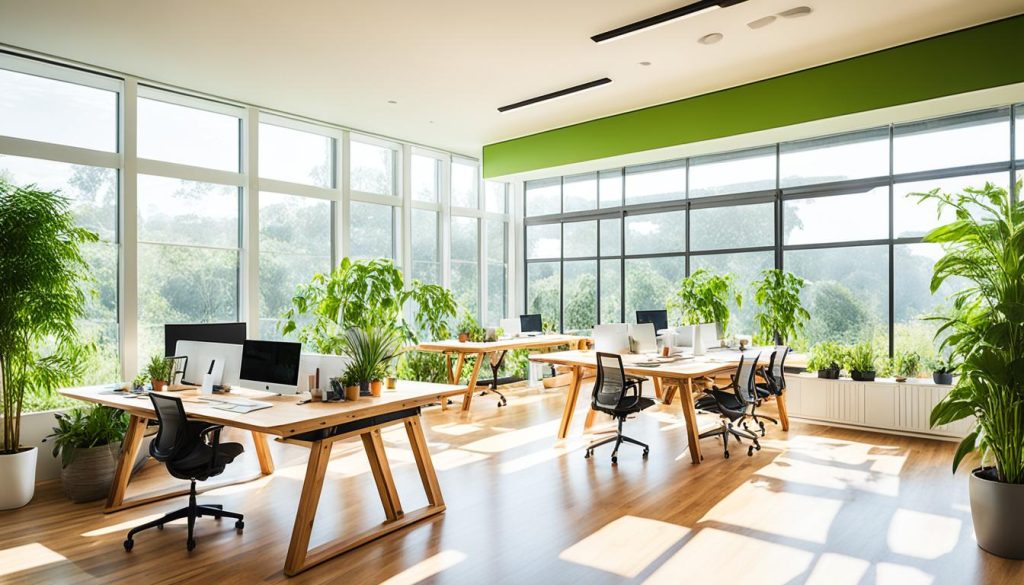
Eco-friendly Cooling and Heating Solutions
Choose eco-friendly cooling and heating for your space. Ceiling fans use less power than air conditioners and can make a room feel cooler. Also, using programmable thermostats helps keep the temperature right while saving energy.
Insulation Techniques for Energy Conservation
Good insulation is vital for saving energy. Use green materials like recycled denim or cellulose for insulation. These materials save energy and help keep the air in your office healthy.
The best temperature for working is between 68 and 76 degrees Fahrenheit. With these tips, you’ll have a comfy, green workspace that helps you work better and be kinder to the planet.
Upcycling and Repurposing for Office Decor
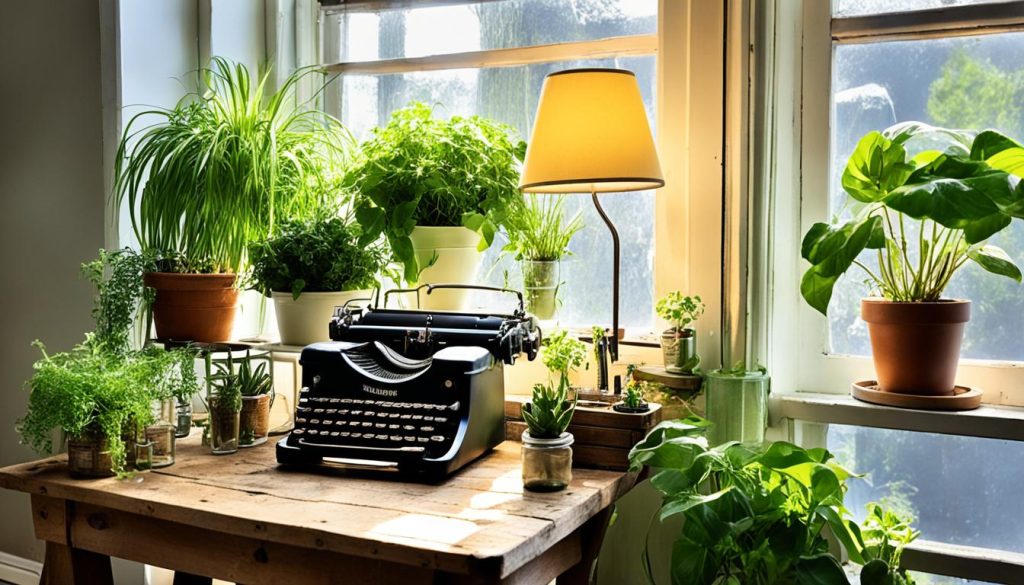
Upcycling is a fun way to make your office eco-friendly. A survey found 64% of companies now use green practices, including upcycling. It’s not only good for the planet but can also save you money. Upcycling can cut furniture costs by up to 30% each year.
Want to try upcycling in your office? Here are some ideas:
- Turn old containers into planters or organizers
- Use vintage items as unique decorations
- Make custom artwork with recycled materials
These projects make your office stand out and help reduce waste. Upcycling can cut office waste by 50%, which means less trash in landfills. With upcycled office decor sales rising by 25% in two years, you’ll be in style.
The TerraDesk is a great example of sustainable office design. It’s made from 10,854 recycled chopsticks. Plus, its 100% cardboard packaging helps save the environment.
Every little bit helps. Whether you’re making faux wood decor or DIY photo frames, you’re supporting a green economy. Your upcycled office will be unique and show you care about the planet.
Ergonomics and Sustainability: Finding the Balance
Creating an eco-friendly home office is more than just picking sustainable materials. It’s about finding a balance between being comfortable and taking care of the environment. The secret is to choose ergonomic furniture that’s great for your body and the earth.
When picking sustainable office furniture, look for items made from recycled plastics or wood from responsible sources. These choices cut down on environmental harm without losing quality. Many brands now offer ergonomic chairs and desks that are both comfy and eco-friendly.
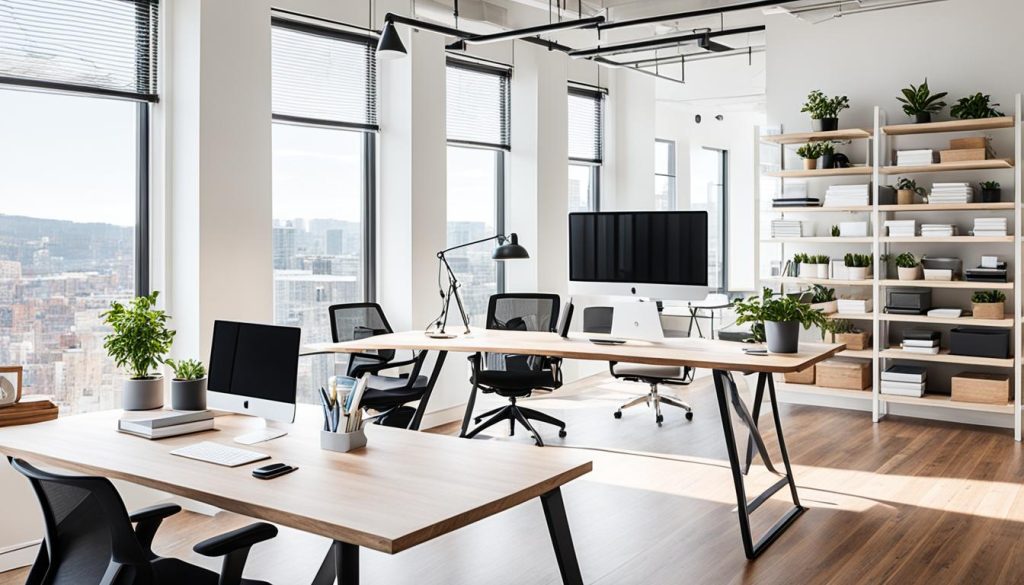
Ergonomic workspaces are key for staying healthy and productive. Think about getting adjustable standing desks that let you switch between sitting and standing all day. This setup not only helps your posture but also makes your furniture last longer, cutting down on waste.
“Sustainability in the workplace isn’t just about being green. It’s about creating a space that nurtures both the environment and the people in it.”
Small changes can have a big impact. Go for energy-saving lights and gear to lower your carbon footprint. By picking ergonomic furniture and eco-friendly habits, you’re looking out for your health and the earth’s future.
- Choose adjustable furniture for longevity
- Look for eco-friendly materials like recycled plastics
- Incorporate standing desk options for flexibility
- Prioritize energy-efficient equipment
By mixing ergonomics and sustainability, you make a workspace that’s comfy, productive, and good for the planet. It’s a win-win for you and the earth.
Closing Thoughts
Starting to make your home office eco-friendly is a big step. It’s not just a trend; it’s essential for our planet. By choosing green office designs, you help your productivity and the planet.
LED light bulbs can cut energy use by 75%. Adding plants boosts well-being and work output. Natural light from sliding glass doors helps you work better and uses less artificial light. Even small actions, like using recycled paper or going paperless, make a big impact.
Your eco-friendly home office is just the beginning. Begin with a Noho move chair or FLOR carpet tiles made from recycled materials. Then, add more sustainable items over time. Every step towards a greener office matters. You’re creating a better future, not just designing an office.

